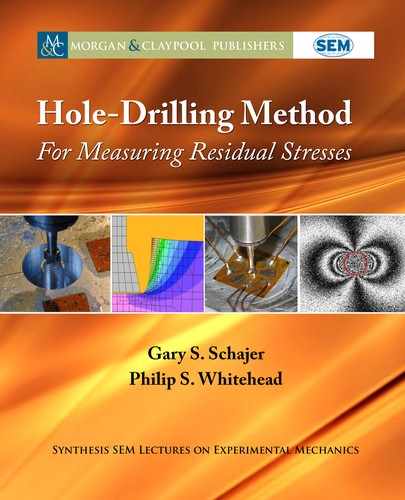20 2. RELAXATION TYPE RESIDUAL STRESS MEASUREMENT METHODS
• Diffractive methods. ese include the X-ray, Synchrotron and Neutron Diffraction
methods. ey involve measuring the diffraction patterns of the given radiation type from
a stressed crystalline material. ese measurements indicate the crystal lattice spacing,
from which the local residual stresses can be evaluated. ese methods have the advantage
of being non-destructive, but are limited to crystalline materials. e X-ray technique can
measure only very near-surface stresses. Synchrotron and Neutron Diffraction measure-
ments can penetrate deeper but can only be done at a very small number of major nuclear
facilities.
• “Other” methods. ese include magnetic, ultrasonic, thermo-elastic and photoelastic
methods. ese are more specialized measurement methods suited to particular materi-
als, based on specific properties of those materials and requiring detailed material-specific
calibrations.
All the various methods have particular strengths that can make them well suited to certain
measurement tasks, and also particular weaknesses that can make them unsuited to others. us,
the method used for a given measurement task must be chosen with knowledge and care to
achieve the best overall result. It is also important to understand and take into account possible
associated limitations and concerns.
e Hole-Drilling Method, the subject of this book, is an example of a relaxation type
method. It is a very versatile method and has a wide range of practical applicability. is chap-
ter gives a general overview of the commonly used relaxation type residual stress measurement
methods so as to place the Hole-Drilling Method in context. It describes the physical features
and concepts that are important to understand when considering relaxation type methods in gen-
eral and the Hole-Drilling Method in particular. In addition, while the Hole-Drilling Method
is a good general-purpose choice, there are many cases where the use of an alternative method is
appropriate. e larger viewpoint presented in this chapter is intended to assist with that choice.
2.2 RELAXATION METHOD CONCEPT
e relaxation methods for measuring residual stresses conceptually parallel the typical proce-
dure used for measuring applied stresses. e method used for applied stresses is to measure
the deformation change that occurs in the given specimen from either addition or removal of
the applied load and then to evaluate the stresses based on the deformation measurements. e
no-load case provides the zero-stress datum. In the case of residual stresses there is no exter-
nal load to manipulate, so instead the “internal load” is manipulated. is is done by cutting
or removing material containing residual stresses. e material cutting creates a stress-free sur-
face, thus forming a zero stress datum locally. e residual stresses in the remaining material
then redistribute themselves so as to re-establish internal force equilibrium. e deformations
associated with this stress redistribution provide the data from which to evaluate the originally
existing residual stresses. Since the material cutting locally reduces the original residual stresses,
..................Content has been hidden....................
You can't read the all page of ebook, please click here login for view all page.
